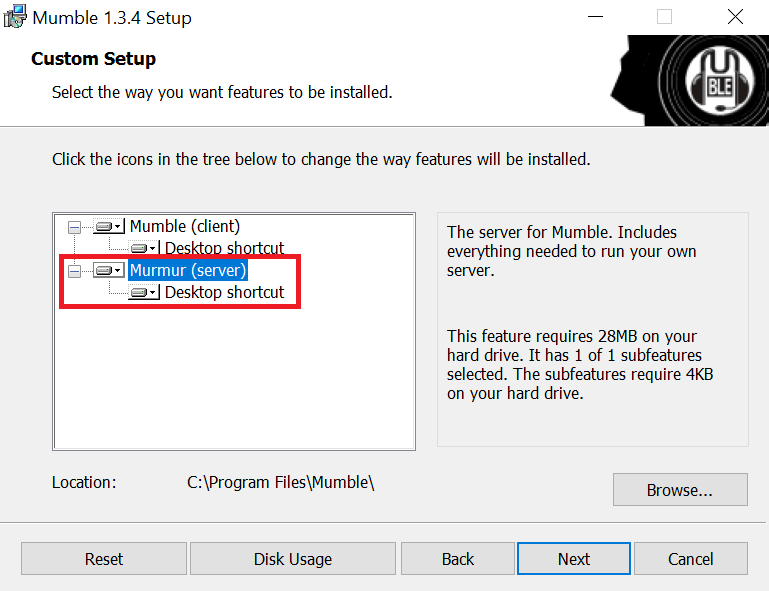

Install murmur and mumble with the usual commands:Įnter fullscreen mode Exit fullscreen modeĪnd chown these by mumble-server group, mumble-server userĭatabase= to database=/var/lib/mumble-server/mumble-server.sqlite = Getting and Installing Murmur and Mumble = Port forward tcp, udp port 64738 using your router interface.Obtain a DNS domain and create one with a dynamic dns provider (e.g.In any case, if anyone talks about Murmur it is for sure the server part. "Murmur" is the name of the server application. The client application or about "Mumble & Murmur" the whole voice chat application suite. People tend to simplify things, so when they talk about Mumble they either talk about "Mumble"

It can be compared to programs like Ventrilo or TeamSpeak. While it can be used for any kind of activity, it is primarily intended for gaming. Mumble is a voice chat application for groups.
MUMBLE SERVERS ARE SAVED HOW TO
It is your decision for what the limit on text data should be and whether or not HTML should be enabled.This "Mumble & Murmur" voice chat application guide shows how to setup the murmur server on Slackel, Salix so a group of users can use The limits on text data and text data with images are also disabled. 0 for no limit.#imagemessagelength=131072 # Allow clients to use HTML in messages, user comments and channel descriptions?#allowhtml=true 0 for no limit.#textmessagelength=5000 # Maximum length of text messages in characters, with image data. Here is how it appears in the configuration file: # Maximum length of text messages in characters. By default HTML in chat, as well as user comments and channel descriptions, is disabled. Mumble has good support for text, images and HTML in chat. It appears like this in the configuration file: # Amount of users with Opus support needed to force Opus usage, in percent.# 0 = Always enable Opus, 100 = enable Opus if it's supported by all clients.#opusthreshold=100 If you set the threshold to 100, it will only be enabled if all users have a version of the client with opus support. If you set the threshold to 0, then the codec will always be enabled. The Opus threshold will put a toggle on the codec. Opus is a coded that can be used by the server in order to improve the quality of the audio sent and received by clients. It appears like this in the configuration file: # Maximum number of concurrent clients ers=100 By default this is set to 100 users but you might to increase or decrease this. This is countered by having a limit to the number of users that connect to the server at any one time. There just isn’t enough bandwidth and processing power available for that to be a viable option. You can’t have an infinite number of users connecting to one Mumble server. The section of configuration file you are looking for looks like this: # Maximum bandwidth (in bits per second) clients are allowed# to send speech at.bandwidth=72000 By default the value is 72000 but you might want to change it to 125000.

This configuration option allows you to put a fixed cap, in bits per second, which a user can send speech to the server. Mumble allows each user to send speech at their own rate to the server.
MUMBLE SERVERS ARE SAVED PASSWORD
If you set a password, it would look something like this: # Password to join server.password=thisisabadpassword By default this is disabled and appears like this in the configuration file: # Password to join server.#password= That could be podcasting, a guild/team server for a game or if you don’t want the server to be open to anybody connecting.

By default this is 64738 and it will appear like this: # Port to bind TCP and UDP sockets toport=64738Ī server password is useful for servers being used for private purposes. This value will hold the port that the server is connected to by. It would appear like this: # Welcome message sent to clients when they connectwelcometext=”Welcome to the LinusTechTips Mumble Server. For example, the welcome text could display a message welcoming people to the LinusTechTips mumble server. While you might want to keep the default text, it is good to have a server that is personal to you. By default it will appear like this: # Welcome message sent to clients when they connectwelcometext=”Welcome to this server running Murmur.Enjoy your stay!” The welcome text is the piece of text that is shown to the user when they initially connect to the server. Before we can change anything, we need to open the mumble-server configuration file this can be done by running the following command: sudo nano /etc/mumble-server.ini We are going to cover how to change the welcome text, port, server password, bandwidth per user, total number of users, opus threshold and text/html in chat. Now we are going to further configure the server in order to have greater control over it.


 0 kommentar(er)
0 kommentar(er)
